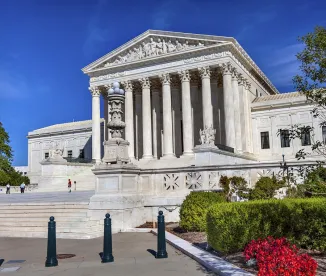Courts’ deference to agency interpretations of their own statutes and regulations has been a mainstay of administrative law. The Chevron Doctrine has since 1984 provided that courts should put a “thumb-on-the-scales in favor of the government’s view of the meaning of [a] statute . . .” as long as the interpretation is reasonable. A similar stance toward agencies’ interpretation of their own regulations dates back to 1945 and is now known as Auer Deference. These doctrines also have a long history of being criticized as violating the separation of powers because they give the agencies much discretion and tend to whittle down legislative and judicial functions.
With Kisor v. Wilkie, No. 18-15, 2019 U.S. LEXIS 4397 (June 26, 2019), the U.S. Supreme Court has dealt a blow to Auer Deference, significantly limiting its scope. In its main opinion, authored by Justice Elena Kagan, the Court made it much more difficult for a court to defer to an agency’s interpretation of its regulations. No longer can a court easily find that the regulation in question is not ambiguous and defer to the agency’s interpretation. Now, courts must go through an exhaustive three-step process to determine whether a regulation is ambiguous enough to be deemed “genuinely ambiguous.”
Although the deference doctrine was not eliminated or overruled, the Kisor Doctrine could be helpful to litigants challenging agency interpretations of immigration regulations. Over the past couple of years, DHS and USCIS have issued new policies, based upon their current interpretation of regulations, that many have found troublesome, especially when it comes to the H-1B visa. Examples that have contributed to a 60-percent RFE rate include:
-
The interpretation of a “bona fide employer-employee” relationship;
-
The definition of an “employer”; and
-
The definition of a “specialty occupation.”
Of course, the Kisor Doctrine could lead to elimination of programs such as OPT and STEM OPT that also come from agency interpretations of their regulations and have been challenged by opponents.
Justices Gorsuch and Kavanaugh have long been proponents of eliminating ChevronDeference. They wrote concurrences in Kisor indicating that they would have wanted to see Auer Deference completely overturned. Justice Roberts noted in a separate concurrence that the distance between the majority and minority view is “not as great as would initially appear.”
We will have to wait and see whether Kisor tips the balance in litigations challenging some recent actions of the immigration agencies. Kisor may be a first stab at restoring more of a balance among the three branches of government, but, because the agencies often rely on statutory interpretation, we may have to wait for a case that challenges Chevron Deference directly to come to the Supreme Court.




 />i
/>i

